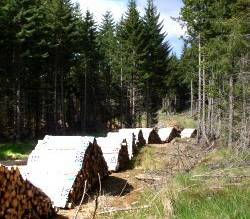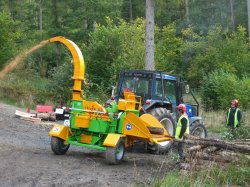 Wood can be used in a variety of different forms but, to make the best use of it, it must be processed to the optimum form for the equipment in use.
Wood can be used in a variety of different forms but, to make the best use of it, it must be processed to the optimum form for the equipment in use.
Freshly harvested, or “green” wood typically has a moisture content of around 50-60% (wet basis). Although some equipment is specifically designed to be able to burn green fuel, most wood chip boilers require a moisture content of around 30-35%, while log stoves and boilers typically require 15-25% moisture content
In order to be able to automate the fuel feed for a biomass boiler, the fuel needs to be converted into a form in which it can be made to flow from a bulk fuel store into the boiler, typically using a screw auger. This is usually done by chipping, but it is critical that the chips are of regular size, without excessive “fines” (dust) or long slivers, that can cause blockages

For most energy applications low moisture content is desirable for woodfuel and biomass. This can be achieved in a number of ways.
Biomass may be dried either passively (without the use of external energy source) or actively (using external heat and/or fans).
Passive drying is generally the cheapest, requires the least additional equipment, requires the least external energy input, but is the slowest. It can be used to achieve a moisture content of 25-30% in most places in the UK, and lower with care and time, however if a lower moisture content is required some active drying may be required. For most combustion systems this is sufficient, however for some gasification or pyrolysis systems, or the manufacture of pellets it may not be.
Wood such as small round wood (SRW), branches or brash should be:
The stack may be under a permanent or temporarily cover, or covered with a waterproof, or semi-permeable sheet, with the cut ends exposed, however a good airflow is the most important factor. Scoring, partial or total removal of bark will assist drying.
Drying time (seasoning time) is dependent upon many parameters of both the material to be dried (shape and size of pieces, wood density, presence of bark) and the storage conditions (method of storage and stacking, air flow, temperature, humidity).
The same basic principles apply for other forms of biomass:
If a moisture content below that which can be achieved in the time available by passive drying alone, is required, then active drying may be necessary. Active drying requires the input of energy from an external source to speed up the process and achieve lower ultimate moisture content.
The use of external energy input usually entails additional cost, and will increase the embedded energy.
For greatest efficiency a large surface area to volume ratio is required of the material to be dried, and good air flow over as much of the surface as possible. Air flow should be increased, making as much use as possible of prevailing winds and/or convection, combined with good ventilation, together with fans or blowers, usually with heating. Moving, turning or spreading the material to maximise the surface area exposed will assist drying.
Heating can be from available excess process heat, or a dedicated heating unit. By careful design and orientation it may be possible to incorporate a significant amount of solar heating.
If there is a supply of very dry material, such as kiln dried timber or offcuts from the furniture industry, it may be appropriate to blend this with material of a higher moisture content to reduce the average figure for the batch.
Although not technically drying this may be a valid technique to ensure that a batch of fuel from a range of sources meets specification.
 What can be chipped?
What can be chipped?Chipping can be performed on small round wood (SRW), or mixed brash. The resultant bulk density will be around 200-400 kg/loose m3, which is less than that of the solid wood, and even packed logs, but more than loose brash.
With suitable equipment chips may be more easily handled, transported and stored than branches and brash, however SRW and logs should usually be transported before chipping owing to the higher bulk density if stacked properly.
Longer pieces allow a longer machine chipping cycle, but add to the stress of hand loading. In the case of hand loading a compromise on piece size need to be made to reduce operator’s strain. This can lead to decreased quality however as a greater number of pieces yields a greater number of end pieces which typically produce oversize slivers when the short end turns sideways after passing through the rollers. When grapple loading, feeding long de-limbed stems with a very small end diameter, butt first, is the best way to optimise output as well as to reduce the proportion of oversized particles.
The processing site should allow minimum handling, movement and transportation both to optimise outputs and minimise operator’s strain.
Stacked wood chips do not allow air to flow easily through the stack. Unless the biomass is very dry this tends to lead to composting and the growth of moulds. Composting leads to loss of biomass and can present a fire hazard owing to the high temperatures created in the core of a large stack.
Advice varies between different sources as to the safe maximum size for stacks of wood chips to minimise the risk of fire, with figures typically around 8-10 m high. The high core temperature in a stack of wood chips can, however, be used to assist drying as moisture is driven out from the core to the periphery.
Spores from moulds growing on piles of stored wood chips have been shown to cause health problems from particle irritation, type I and type II allergic responses, potentially toxic volatile organic compounds (VOCs) and mycotoxins, and inflammatory reactions to cell wall components when inhaled. A P3 filter dust mask should be worn when working in proximity to stores or deliveries of stored chips.
Wood chip boilers have constraints on the parameters of the wood chips to be used. The choice of chipper used is important if the wood chips are to be used with many types of feed mechanisms, especially auger feeds as found on many wood chip heating systems. General purpose chippers designed primarily for volume reduction do not usually produce chips suitable for use with many auger feeds which require chips of closely defined dimensions, with low levels of fines or slivers. Slivers in particular can cause difficulties as they can bridge or jam the auger.
You should give careful consideration to:
Regular maintenance of the chipper components and settings will guarantee a consistent particle size distribution; the main factors that will influence chips size are:
Material can sometimes ‘kick back’ out of the infeed because of form, length, or aggressive infeed rollers. Operator should not remain in front of the chipper infeed more than necessary.
Due to the ‘megaphone effect’ of the conical shape of infeed chutes, sound pressure is very high at the very position where the operator stands to load the machine. Some chippers designs achieve reduced noise levels, and adjustments to the chipper settings can although help. The operator must wear ear protection relevant to the level and length of exposure.
Comprehensive guidance regarding the safe use of chippers is available from the Health and Safety Executive.
There is more information about chippers and further information to download: